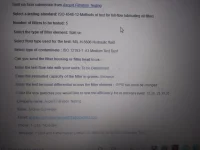Ascent Filtration Testing
Thread starter
- Joined
- Nov 29, 2020
- Messages
- 184
I would look at the particles under a microscope to identify them and get a size. If that doesn't work a send a sample to a lab and run a mass spectrometer for composition.
If you want a size and distribution run a sample through a particle size analyzer (I plan on getting a used Horiba).
Use the microscope size in tandem with a batch sample run it through a particle sensor for good measure and count for the sizes from the analyzer test.
Run an efficiency test on the partially used filter with the discovered particle sizes. See if they are captured. If not select the most efficient filter you can find and plumb two of them in parallel with a deltaP gauge to indicate when to change them.
All I can help you with here is testing the current filter new and used for efficiency and capacity to discover if it is trapping the particle sizes of interest, and testing a better replacement filter for the same size particles. Also testing a batch sample of dirty fluid and discovering numbers and sizes of particles in it to select a better media.
If you want a size and distribution run a sample through a particle size analyzer (I plan on getting a used Horiba).
Use the microscope size in tandem with a batch sample run it through a particle sensor for good measure and count for the sizes from the analyzer test.
Run an efficiency test on the partially used filter with the discovered particle sizes. See if they are captured. If not select the most efficient filter you can find and plumb two of them in parallel with a deltaP gauge to indicate when to change them.
All I can help you with here is testing the current filter new and used for efficiency and capacity to discover if it is trapping the particle sizes of interest, and testing a better replacement filter for the same size particles. Also testing a batch sample of dirty fluid and discovering numbers and sizes of particles in it to select a better media.

